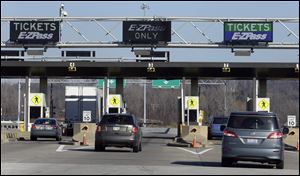
Ohio Turnpike and Infrastructure Commission raises tolls
It's the first of 10 annual increases to pay for big road projects
7/15/2013
For drivers who travel more than 30 miles on the turnpike and don’t have E-ZPass, tolls will climb 2.7 percent as of Jan. 1.
COLUMBUS — The newly renamed Ohio Turnpike and Infrastructure Commission today essentially handed a loan repayment book to drivers on the 241-mile toll road for what will ultimately be $1.5 billion in borrowing to fund non-turnpike transportation projects.
For drivers who travel more than 30 miles on the turnpike and don’t have E-ZPass, tolls will climb 2.7 percent as of Jan. 1, the first of 10 such annual increases expected to repay the bonds. The increases would be tied to the regional rate of inflation.
The commission today also agreed to issue the first $1 billion in bonds with the other $500 million to come later. In all, the $1.5 billion is expected to draw matching federal and local funds to generate a total construction budget of $3 billion.
The borrowing includes $70 million to help the turnpike pay for its ongoing replacement of the original highway deck.
The move was designed to jump-start non-turnpike projects that might otherwise have languished for decades because of stagnated gas tax revenue and federal highway funds. The construction projects are expected to create about 65,000 jobs.
“I believe this is the most important time in the turnpike’s history since the road was first built,” said Executive Director Richard Hodges.
The toll increases were authorized earlier this year in legislation that, for the first time, borrows against the dollar value of the turnpike across northern Ohio to pay for highway and bridge projects well off the east-to-west toll road corridor. The turnpike’s debt would be roughly quadrupled, but the borrowing has drawn strong ratings from Wall Street’s credit rating agencies.
E-ZPass-using commuters traveling less than 30 miles between exits would see no increases, but tolls for everyone else are now scheduled to climb 2.7 percent a year for the next 10 years. For example, an E-ZPass passenger car traveling between the 1-280 interchange in Lake Township to State Route 4 near Sandusky would see tolls climb from the current $1.75 to $2 in 2015 and then to $2.25 in 2020.
For passenger-car drivers using E-ZPass and traveling the entire stretch of the highway, tolls would rise 25 cents to $11.50 next year and eventually reach $14.75 after a decade.
The new law requires that at least 90 percent of the borrowed money be spent within 75 miles of the turnpike corridor, which, along I-75, could stretch about as far south as Lima. That provision was designed to address concerns by lawmakers from northern Ohio that the region should not be asked to subsidize toll-free highways and bridges in southern Ohio.
The process of identifying projects that would benefit from the turnpike borrowing is already under way. On July 25, the state Transportation Review and Advisory Council, which sets the major road and bridge construction priorities for the state, is expected to approve a draft list of projects that, for the first time, will include those that could see turnpike-related funding.
Following a public comment prior, TRAC is expected to finalize a list on Aug. 22 and ultimately make recommendations to the turnpike commission. The commission may consider only projects deemed to have some “nexus” with the toll road.
Among the projects mentioned in northwest Ohio are a rebuild of the interchange of I-475 and I-75, upgrades to the I-475 junction with U.S. 23 in Sylvania Township and the nearby Central Avenue interchange.